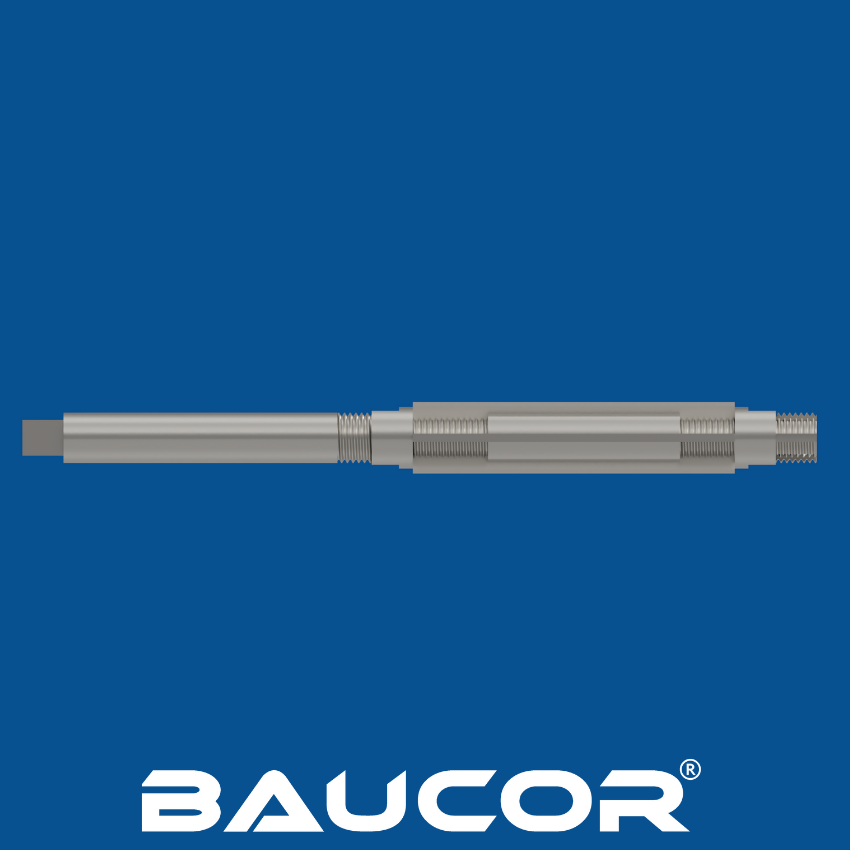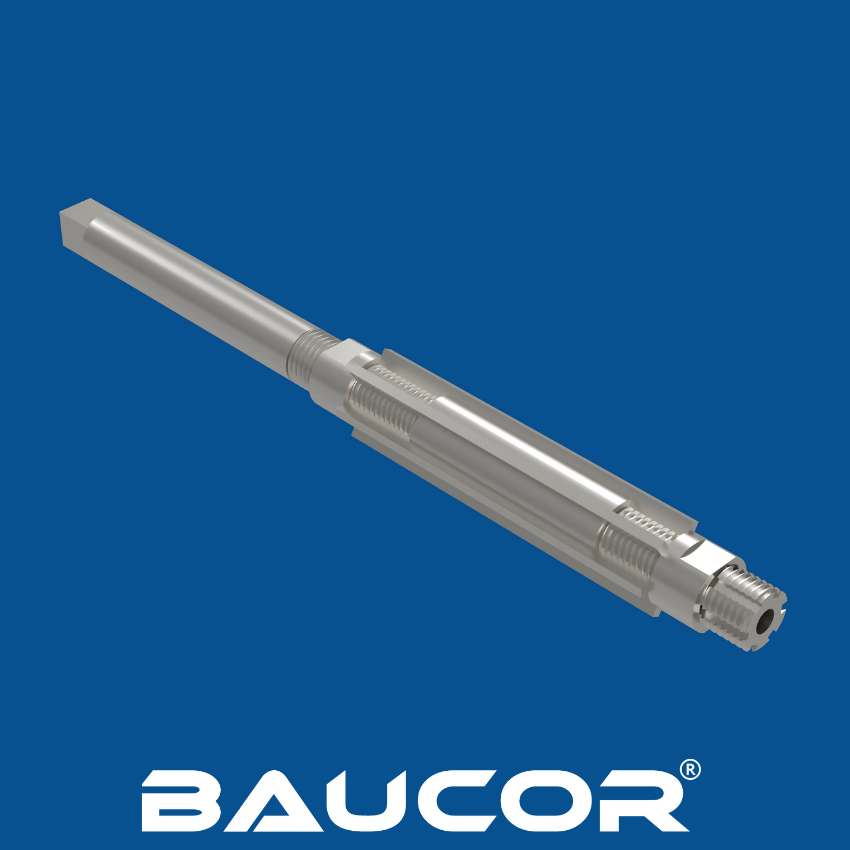BAUCOR REAMERS:
UNLEASH THE POWER OF PRECISION.
EXPERIENCE ENHANCED PERFORMANCE, SUPERIOR SURFACE FINISH, AND UNMATCHED DURABILITY.
BAUCOR REAMERS:
UNLEASH THE POWER OF PRECISION.
EXPERIENCE ENHANCED PERFORMANCE, SUPERIOR SURFACE FINISH, AND UNMATCHED DURABILITY.
Adjustable reamers, also known as expansion reamers, are cutting tools designed to enlarge and finish holes to a precise diameter within a specific range. Unlike fixed reamers that have a set diameter, adjustable reamers feature an adjustable blade or cutter mechanism, allowing them to be set to different sizes within their specified range. This flexibility makes them valuable tools in various machining and maintenance applications.
How Adjustable Reamers Work

Adjustable reamers, known for their versatility in hole sizing, are manufactured through a specialized process that combines precision engineering with adjustable mechanisms.
Body Construction:
Cutting Blades:
Adjusting Mechanism:
Wedge and Screw Mechanism: A tapered wedge is moved along a slot in the reamer body by tightening or loosening a screw, adjusting the diameter of the cutting blades.
Assembly:
Heat Treatment:
Coating (Optional):
Inspection and Quality Control:
Marking and Packaging:
By adhering to these manufacturing steps and employing precise machining techniques, manufacturers can produce high-quality adjustable reamers that offer flexibility, precision, and durability for a wide range of hole sizing applications.

As a leading manufacturer of cutting tools, Baucor likely offers a wide range of adjustable reamer sizes to cater to the diverse needs of their customers across various industries. While their specific product catalog may vary, you can expect the following size ranges and types:
Hand Reamers:
Machine Reamers:
Adjustable Reamer Types:
Additional Considerations:
Obtaining Precise Information:
To obtain the most accurate and up-to-date information on the specific sizes of adjustable reamers manufactured by Baucor, it is recommended to:
By utilizing these resources, you can ensure that you select the perfect Baucor adjustable reamer for your machining applications.
Adjustable reamers are manufactured using various materials, each with its unique properties to suit different applications and workpiece materials. Here's a list of the possible materials used:
Reamer Body:
Cutting Blades:
Adjusting Mechanism:
Optional Coatings:
Choosing the right material for an adjustable reamer depends on the specific application, the workpiece material, the desired surface finish, and budget considerations. For most general-purpose reaming, HSS is a suitable and cost-effective choice. However, for harder materials, high-volume production, or demanding applications, cobalt or carbide blades may be more appropriate. Consulting with a knowledgeable supplier or manufacturer can help you select the best material for your specific needs.

Reamers with blades that can be adjusted to slightly vary the hole size.

Long reamers used to accurately ream holes in bridge construction.

Reamers specifically designed for use in automotive manufacturing.

Reamers designed to create or finish chambers in firearms.
Adjustable reamers can benefit from various coatings to enhance their performance, durability, and versatility. Here are the common and specialized coatings used:
Common Coatings:
Specialized Coatings:
Choosing the Right Coating:
The ideal coating for an adjustable reamer depends on several factors, including:
Consulting with the reamer manufacturer or a knowledgeable supplier can help you select the optimal coating for your specific needs. By considering the material, reaming conditions, desired tool life, and required surface finish, you can ensure that your adjustable reamer delivers the best possible performance and longevity.

Tools that combine a drill and a reamer in one.

Similar to adjustable reamers, these can be expanded slightly to increase the hole size.

Reamers designed to be turned by hand, typically with a square drive.

Reamers with left-hand spiral flutes, used to prevent the reamer from pulling itself into the hole.
Adjustable reamers, due to their flexibility and precision, find applications across various industries and workshops where accurate hole sizing and finishing are essential. Here's a breakdown of their common uses:
Industrial Applications:
Other Applications:
DIY and Home Use:
Overall, adjustable reamers are versatile tools that find applications across a wide range of industries and tasks where precise and adjustable hole sizing is essential. Their adaptability and precision make them valuable assets in manufacturing, repair, and maintenance operations.
Adjustable reamers, known for their versatility and precision, find applications across a wide range of industries that require accurate hole sizing and finishing. Here are some of the key industries that utilize adjustable reamers:
The versatility of adjustable reamers makes them indispensable tools in numerous industries where accuracy, surface finish, and component fit are critical. Their ability to adjust to different hole sizes within a specified range makes them a cost-effective and efficient solution for various machining and maintenance tasks.
Adjustable reamers are versatile tools compatible with various machines, providing flexibility for precise hole sizing and finishing. Here are the main types of machines that utilize adjustable reamers:
Hand-Held Operations:
Machine Operations:
Choosing the right machine for using adjustable reamers depends on several factors:
By understanding the capabilities of different machines and considering your specific needs, you can choose the most suitable machine for using adjustable reamers to achieve precise and smooth holes in your workpieces.
At Baucor, we are committed to being more than just a cutting tool supplier. We are your dedicated partner in achieving machining excellence. Our comprehensive suite of design and engineering support services for adjustable reamers is a testament to this commitment.
Our experienced engineers will work closely with you to design custom adjustable reamers tailored to your unique requirements. We meticulously analyze your needs and optimize reamer geometry, materials, and coatings to ensure your reamer delivers exceptional performance and precision.
We understand that choosing the right materials and coatings is crucial. That's why we offer expert guidance, considering factors such as workpiece material, tolerance, surface finish, and production volume to recommend the optimal solutions.
Our commitment extends to optimizing your entire reaming process. We analyze your existing procedures, suggesting improvements to maximize efficiency, reduce tool wear, and boost productivity.
Our technical support team is always available to address any issues you may encounter. Whether through on-site troubleshooting, remote assistance, or access to our knowledge base, we ensure your reamers consistently perform at their best.
We believe in empowering our customers with knowledge. That's why we offer training programs and workshops to educate your team on the proper use and maintenance of adjustable reamers, maximizing their lifespan and effectiveness.
And to ensure your reamers maintain peak performance, we offer calibration and repair services, minimizing downtime and extending the life of your investment.
At Baucor, we are more than just a manufacturer; we are your partner in precision machining. With our comprehensive design and engineering support services, you can trust that your adjustable reamers will consistently deliver exceptional results, increasing productivity, reducing costs, and enhancing your product quality.

Reamers designed to be used in a machine, such as a lathe or milling machine. blades that can be adjusted to slightly vary the hole size.

Reamers with a Morse taper shank for secure holding in a machine spindle.

Reamers with a pilot that guides the tool for accurate alignment.

Reamers with a hollow cylindrical shape, often used with an arbor.

BAUCOR offers custom manufacturing and engineering solutions tailored to your specific needs, across various industries.

BAUCOR's engineers can review your design and provide feedback to improve manufacturability, cost effectiveness, and efficiency.


Barrel reamer design is crucial for achieving precise bore dimensions and smooth finishes, directly impacting firearm accuracy and performance. Here are the key design guides for barrel reamers:
Pilot Diameter and Length:
Cutting Edge Geometry:
Material Selection:
Coating (Optional):
Shank Design:
Overall Length:
Specialized Reamer Designs:
By adhering to these design guidelines and selecting the right materials and coatings, manufacturers can produce high-quality barrel reamers that deliver the precision, accuracy, and performance required for firearm manufacturing and gunsmithing.